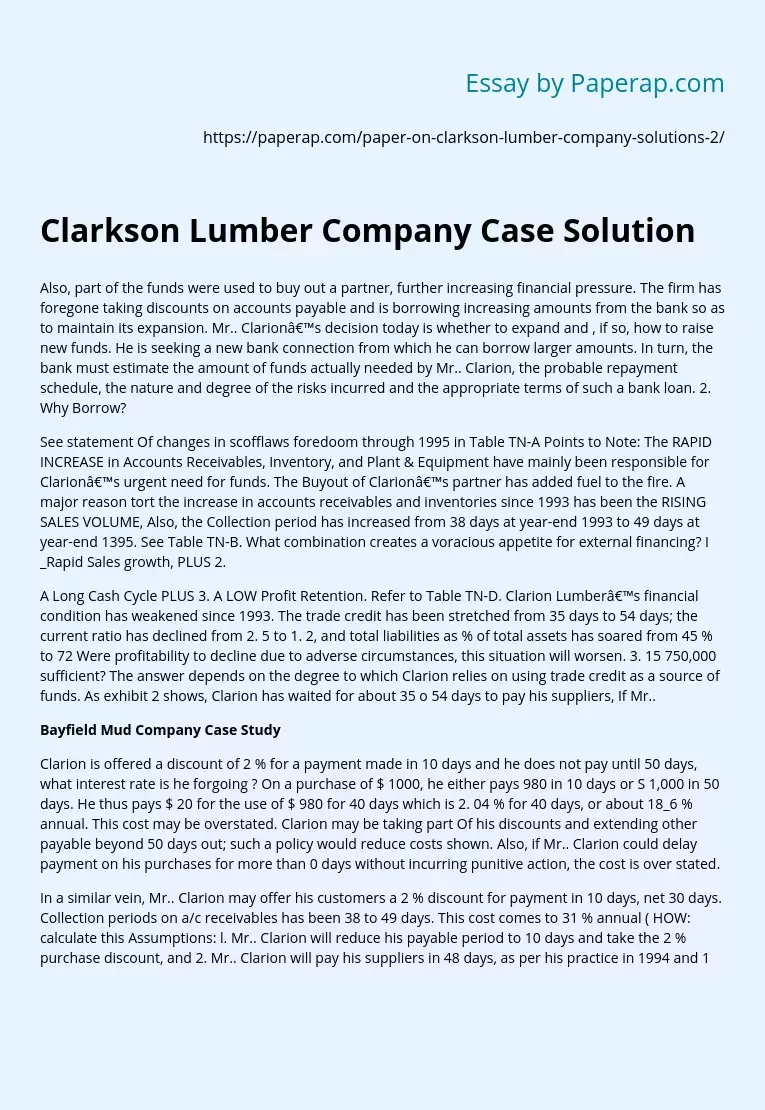Clarkson Lumber Company Case Solution
Also, part of the funds were used to buy out a partner, further increasing financial pressure. The firm has foregone taking discounts on accounts payable and is borrowing increasing amounts from the bank so as to maintain its expansion. Mr.. Clarion’s decision today is whether to expand and , if so, how to raise new funds. He is seeking a new bank connection from which he can borrow larger amounts. In turn, the bank must estimate the amount of funds actually needed by Mr.
. Clarion, the probable repayment schedule, the nature and degree of the risks incurred and the appropriate terms of such a bank loan. 2. Why Borrow?
See statement Of changes in scofflaws foredoom through 1995 in Table TN-A Points to Note: The RAPID INCREASE in Accounts Receivables, Inventory, and Plant & Equipment have mainly been responsible for Clarion’s urgent need for funds. The Buyout of Clarion’s partner has added fuel to the fire. A major reason tort the increase in accounts receivables and inventories since 1993 has been the RISING SALES VOLUME, Also, the Collection period has increased from 38 days at year-end 1993 to 49 days at year-end 1395.
See Table TN-B. What combination creates a voracious appetite for external financing? I _Rapid Sales growth, PLUS 2.
A Long Cash Cycle PLUS 3. A LOW Profit Retention. Refer to Table TN-D. Clarion Lumber’s financial condition has weakened since 1993. The trade credit has been stretched from 35 days to 54 days; the current ratio has declined from 2. 5 to 1. 2, and total liabilities as % of total assets has soared from 45 % to 72 Were profitability to decline due to adverse circumstances, this situation will worsen.
3. 15 750,000 sufficient? The answer depends on the degree to which Clarion relies on using trade credit as a source of funds. As exhibit 2 shows, Clarion has waited for about 35 o 54 days to pay his suppliers, If Mr..
Bayfield Mud Company Case Study
Clarion is offered a discount of 2 % for a payment made in 10 days and he does not pay until 50 days, what interest rate is he forgoing ? On a purchase of $ 1000, he either pays 980 in 10 days or S 1,000 in 50 days. He thus pays $ 20 for the use of $ 980 for 40 days which is 2. 04 % for 40 days, or about 18_6 % annual. This cost may be overstated. Clarion may be taking part Of his discounts and extending other payable beyond 50 days out; such a policy would reduce costs shown. Also, if Mr.. Clarion could delay payment on his purchases for more than 0 days without incurring punitive action, the cost is over stated.
In a similar vein, Mr.. Clarion may offer his customers a 2 % discount for payment in 10 days, net 30 days. Collection periods on a/c receivables has been 38 to 49 days. This cost comes to 31 % annual ( HOW: calculate this Assumptions: l. Mr.. Clarion will reduce his payable period to 10 days and take the 2 % purchase discount, and 2. Mr.. Clarion will pay his suppliers in 48 days, as per his practice in 1994 and 1995. 3. Sales Volume will be S S. S million in 1996. 4. The historical relations between 1993-1995 will continue in 1996. Table TN-E shows a projected income statement for I egg and Table TN-V shows a projected balance sheet.
Observe that Clarion needs to borrow $ 971, 000 at the end of 1996 and his PEAK loan requirements may be higher due to I) he may need to finance a larger volume Of current assets during his seasonal peak, which occurs well before the end of the year, and 2) at this time, he will have accumulated only a portion of his total retained earnings for the year. The plan of action proposed by Mr.. Clarion poses MAJOR DIFFICULTIES. Several alternatives are available: 1 . Get MORE bank credit 2. Slow Down his projected rate of expansion, or . Continue to rely heavily on trade credit and pay off bills slowly.
In the third case, if Mr.. Clarion waits 50 days to pay off his bills, he will have a/ c payable of S 580,000 outstanding reducing his bank borrowings well below 4 750,000 but will the bank lend now ? DECISIONS, DECISIONS: See Figure TN-A for a mapping of major alternatives. Mr.. Clarion can expand his operations rapidly but can he increase profits as rapidly ? TO do so, he Will need more financing unless he relies on high cost trade credit. Continued expansion at a rate that cannot be financed proportionately from retained earnings can leave in in a vulnerable high risk position.
Clarkson Lumber Company Case Solution. (2019, Dec 05). Retrieved from https://paperap.com/paper-on-clarkson-lumber-company-solutions-2/

